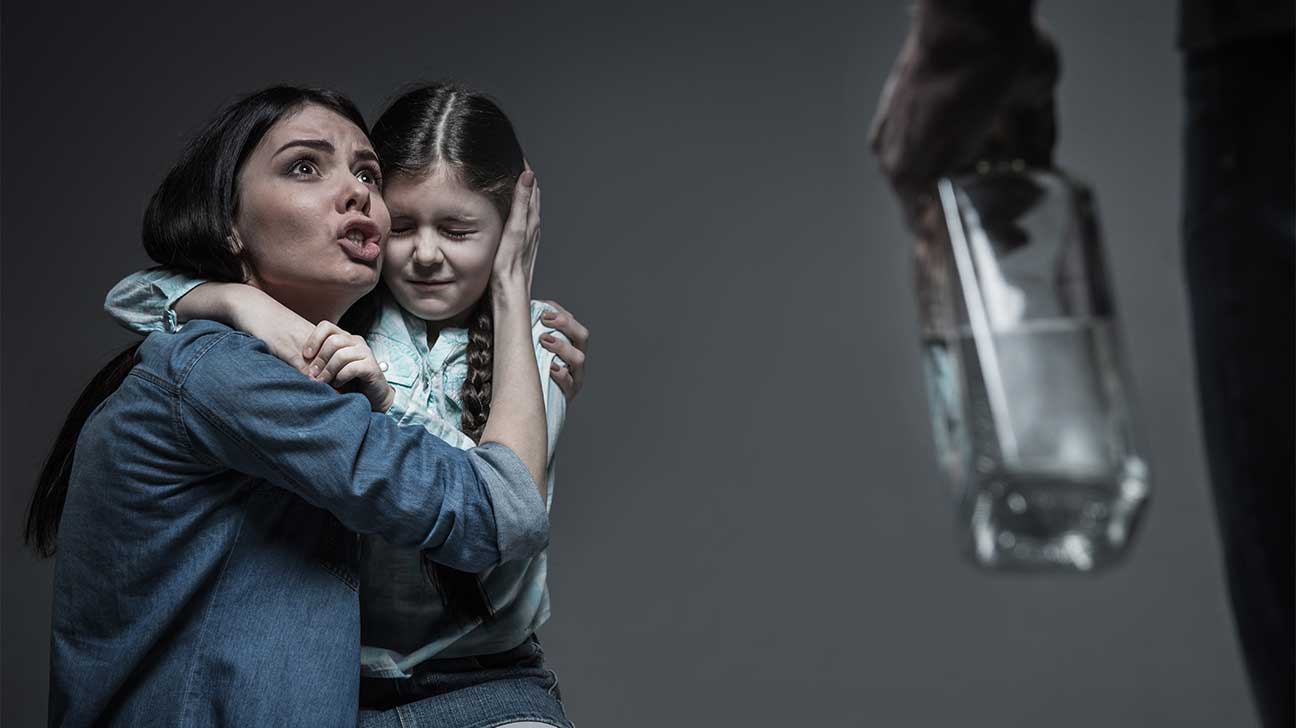
Substance abuse and domestic violence are connected in many different ways, each of which harms both people in the relationship.
The Substance Abuse and Mental Health Services Administration (SAMHSA) defines domestic violence as the use of intentional emotional, psychological, sexual, or physical force by one family member or intimate partner to control another.
Those who abuse substances are more likely to commit acts of domestic violence, and the victims of such acts are also at a higher risk of abusing drugs or alcohol.
Whether it be to escape their abusive partner, relieve pain from physical abuse, or treat symptoms of mental illness, substances can quickly become a coping strategy.
Substance Abuse And Domestic Violence Statistics
Several reports and studies have examined the connection between substance abuse and domestic violence.
Here are a few important substance abuse and domestic violence facts:
- about one fourth to half of the men who commit acts of domestic violence also have substance abuse problems
- a large percentage of convicted batterers were raised by parents who abused substances
- in 40% to 60% of intimate partner violence (IPV) incidents, substance abuse was also involved
- on days of heavy substance use, physical violence is 11 times more likely to occur among IPV batterers and victims
- more than 20% of men report using substances before their most recent and severe acts of violence
Research from the American Psychological Association (APA) shows that drug and alcohol dependency increases both the risk of being abused and becoming an abuser.
Victims Of Domestic Violence In Substance Abuse Recovery
Many women in addiction recovery report experiencing some form of abuse in their lifetime.
This substance use may be a direct result of IPV, or a combination of multiple interconnected factors, such as housing issues, financial stress, limited social support, and more.
The National Center on Domestic Violence, Trauma & Mental Health (NCDVTMH) reported research that found:
- of women getting addiction treatment, 47% experienced IPV
- of women getting addiction treatment, 67% reported experiencing physical IPV in the past six months
- of women who use injectable drugs, 31% experienced physical and sexual IPV in the past year
- of women getting methadone treatment, 90% experienced IPV in their lifetime
These women were at a great disadvantage to developing substance use disorders as a direct result of IPV.
One study of low-income women found that IPV survivors saw a rate of 26% for substance abuse as compared to those who had not experienced IPV (5%).
Other research shows that women who were recently victims of IPV had nearly six times the risk of problematic alcohol use, and IPV survivors are twice as likely to undergo alcohol treatment.
Substances As A Means Of Control In Domestic Violence
Though the numbers above reveal a great need for treatment among IPV victims, these people are often prevented by their partners from getting help.
Research from the NCDVTMH notes that domestic abuse is rooted in patterns of power and control.
This ongoing pattern is reinforced through:
- intimidation
- threats
- physical or sexual violence
- isolation
- economic abuse
- stalking
- psychological abuse
- coercion related to mental health and substance use
Many abusers use substance use as a control mechanism over their partners. For example, an abuser may force their partner to use substances, then sabotage any efforts toward recovery.
They do this by threatening to go to the authorities with evidence of their partner’s substance use if they were to speak up about the abuse.
This tactic then strips the victim of his or her ability to seek help, keeping them under the control of their abuser and perpetuating unhealthy power dynamics.
Research is still limited on this topic, but recent studies have been showing increasing evidence to support the fact that substance use coercion is common within abusive relationships.
The Role Of The Abuser’s Substance Use In Domestic Violence
Substance abuse is not always necessarily the cause of domestic violence among batterers, but there are cases in which substances play a key role in the abuse due to direct and indirect factors.
Women whose partners drank heavily were five times more likely to also report experiencing IPV. Other research shows that substance use precedes 47% of domestic assaults.
Of those assaults, 92% of men who assaulted their female partner used substances on the day of the assault, and 30% to 40% were drinking at the time of the assault.
The most common substances involved in these cases were found to be alcohol and cocaine.
An abuser’s substance use can have the following effects:
- It can lead to the serious injury or death of their partner in cases of domestic abuse.
- Substance abuse may lead to misconceptions about a partner’s actions or motives, leading abusers to believe their actions are justified.
- Abusers can use substances as an excuse after the fact, claiming they were intoxicated and unaware of their actions.
- Abusers may believe they have the right to dominate their partner, especially when under the influence of substances.
The Mental Effects Of Substance Abuse And Domestic Violence
Unfortunately, there are many lasting effects that domestic violence can have on a person, especially when substances are involved.
These consequences include physical, emotional, and mental ramifications that may last months, years, or a lifetime.
According to ASAM, those who experience domestic abuse are at an increased risk of developing serious mental health problems.
According to researchers:
- over half (56%) of women who experience IPV are diagnosed with a psychiatric problem
- those who experience IPV are more likely to use tobacco and marijuana
The victims of domestic abuse involving substances are much more likely to deal with mental health problems, including mental illness and substance use disorders.
This abuse can also lead to disordered eating and behavior. The ASAM found a significant correlation between IPV, morbid obesity, and disturbed eating behaviors.
PTSD And Depression Among IPV Victims
The NCDVTMH study found that the two most common disorders among those who have experienced IPV are depression and PTSD.
Women who have experienced IPV are nearly three times more likely to be diagnosed with major depressive disorder.
Many of these mental health effects may be rooted in and perpetuated by substances. Women who report IPV and alcohol problems are eight times more likely to be depressed.
Warning Signs Of Domestic Violence And Substance Abuse In A Relationship
To best protect yourself or your loved one, you need to be aware of the typical warning signs of abuse.
There are certain signs and symptoms that are specific to abusers and victims who experience both domestic violence and substance misuse.
These include:
- words and actions of manipulation
- claiming the abuse will stop once the abuser gets sober, convincing the victim to remain in the relationships
- controlling a partner’s ability to get counseling, talk to friends or family members, or seek treatment for addiction issues
- excusing bad behavior because of substance use
- signs of physical bruising, scars, or other blemishes on the body
- coercing a partner into using drugs or alcohol
- making threats
- blaming violence or substance use on the victim
- cold, cruel, and harmful behavior even when not under the influences of drugs or alcohol
- increased aggression, use of hurtful language, and psychological torment when under the influence of substances, or directly after use
- the victim using substances to escape from or cope with abusive behavior from their partner
- fearing one’s safety when an abusive partner is using substances
Treatment Options For Substance Abuse And Domestic Violence
Researchers from SAMHSA urge addiction treatment providers to look deeper into the issue of domestic violence.
Before entering a rehab program, a person should be screened for any current or past experiences of abuse, which include childhood trauma, abuse in a marriage, or another instance of violence.
There is hope for those who have committed abuse and those who have been victims of violent acts.
With a substance abuse treatment program, a person will undergo treatment that addresses not only the addiction but also the underlying issues that led to the addiction.
The following treatment methods may be used in some addiction programs to address domestic violence:
- individual therapy
- group therapy
- family or couples therapy
- peer-led domestic violence groups
- anger management classes
- trauma-informed therapy
- suicide prevention programs
- life skills development
- dual diagnosis treatment (such as for co-occurring substance use and PTSD, depression, etc.)
- connecting with the local community for outside support
- aftercare or relapse prevention measures that provide ongoing support and guidance
It’s important to note that a standard addiction treatment plan alone will not be enough to end the abuse. An abuser must go through extensive treatment for the addiction and abusive behaviors.
Resources For Victims And Loved Ones
If you or someone you love are experiencing domestic abuse, there are places you can turn to. We’ve gathered a list of helpful organizations that can extend help during this time.
Helplines for domestic abuse victims:
- Love is Respect National Teen Dating Abuse Hotline: Call (866) 331-9474 or text LOVEIS to 22522
- National Domestic Violence Hotline (NDVH): Call (800) 799-7233 or text START to 88788
- Rape, Abuse, and Incest National Network (RAINN) National Sexual Assault Hotline: Call (800) 656-HOPE
- StrongHearts Native Helpline: Call (844) -762-8483 for culturally appropriate dating and sexual violence support for American Indians and Alaska Natives
Organizations dedicated to helping victims of abuse:
- Futures Without Violence: This organization offers free webinars, guides, toolkits, and more related to domestic violence and other problems.
- National Center on Domestic Violence, Trauma & Mental Health: Resources are available for advocates, substance abuse, treatment, sexual assault, and more.
- National Resource Center on Domestic Violence (NRCDV): Find information to resource yourself and others experiencing domestic violence.
Identifying the signs and symptoms of domestic abuse:
- Mayo Clinic, Domestic violence against women: Recognize patterns, seek help: Mayo Clinic covers how to recognize abuse, the issue of blame, seeking help, and more.
- HelpGuide, Domestic Violence and Abuse: This resource identifies the signs of domestic abuse.
- National Coalition Against Domestic Violence (NCADV), Signs of Abuse: Discusses the traits of domestic abusers and warning signs.
- NDVH, Identify Abuse: Learn how to identify signs of abuse, the dynamics of power and control, why people abuse, and more.
Addiction Resource aims to provide only the most current, accurate information in regards to addiction and addiction treatment, which means we only reference the most credible sources available.
These include peer-reviewed journals, government entities and academic institutions, and leaders in addiction healthcare and advocacy. Learn more about how we safeguard our content by viewing our editorial policy.
- American Psychological Association — Intimate Partner Violence
https://www.apa.org/topics/physical-abuse-violence/intimate-partner - American Society of Addiction Medicine — Intimate Partner Violence and Co-Occurring Substance Abuse/Addiction
https://www.asam.org/Quality-Science/publications/magazine/read/article/2014/10/06/intimate-partner-violence-and-co-occurring-substance-abuse-addiction - Mayo Clinic — Domestic violence against women: Recognize patterns, seek help
https://www.mayoclinic.org/healthy-lifestyle/adult-health/in-depth/domestic-violence/art-20048397 - National Center on Domestic Violence, Trauma & Mental Health — The Relationship Between Intimate Partner Violence and Substance Use
http://www.nationalcenterdvtraumamh.org/wp-content/uploads/2014/09/IPV-SAB-Final202.29.1620NO20LOGO-1.pdf - Substance Abuse and Mental Health Services Administration — Substance Abuse Treatment and Domestic Violence
https://store.samhsa.gov/sites/default/files/SAMHSA_Digital_Download/SMA12-3390_508.pdf


